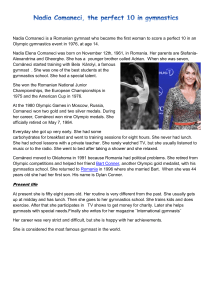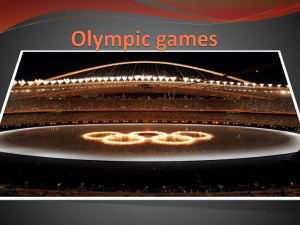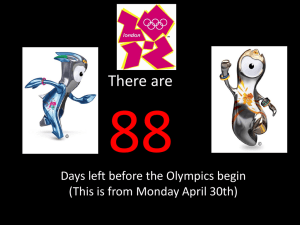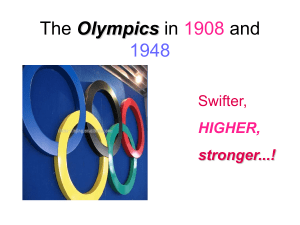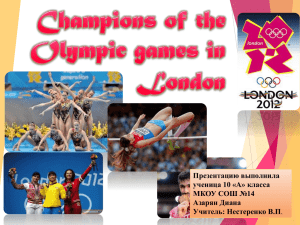History of a winning nation
advertisement
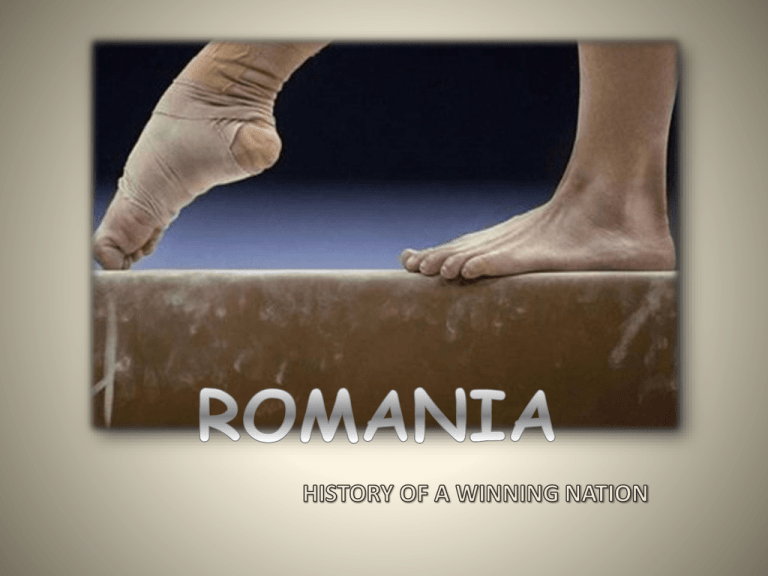
Content: • • • • • • • Symbols Opening Nadia Comaneci Marian Dragulescu Catalina Ponor Simona Amanar Artistic gymnastics History of a winning nation Symbols The Olympic Movement uses symbols to represent the ideals embodied in the Olympic Charter. The Olympic symbol, better known as the Olympic rings, consists of five intertwined rings and represents the unity of the five inhabited continents (Africa, America, Asia, Oceania, Europe). The colored version of the rings—blue, yellow, black, green, and red—over a white field forms the Olympic flag. These colors were chosen because every nation had at least one of them on its national flag. The flag was adopted in 1914 but flown for the first time only at the 1920 Summer Olympics in Antwerp, Belgium. It has since been hosted during each celebration of the Games. The Olympic motto, Citius, Altius, Fortius, a Latin expression meaning "Faster, Higher, Stronger" was proposed by Pierre de Coubertin in 1894 and has been official since 1924. The motto was coined by Coubertin's friend the Dominican priest Henri Didon OP, for a Paris youth gathering of 1891. Coubertin's Olympic ideals are expressed in the Olympic creed: The most important thing in the Olympic Games is not to win but to take part, just as the most important thing in life is not the triumph but the struggle. The essential thing is not to have conquered but to have fought well. History of a winning nation Opening Gymnastics at the Summer Olympics Gymnastics events have been contested at every Summer Olympic Games since the birth of the modern Olympic movement at the 1896 Summer Olympics in Athens. For 32 years, only men were allowed to compete. Beginning at the 1928 Summer Olympics in Amsterdam, women were allowed to compete in artistic gymnastics events as well. Rhythmic gymnastics events were introduced at the 1984 Summer Olympics in Los Angeles, and Trampolining events were added at the 2000 Summer Olympics in Sydney. History of a winning nation Nadia Elena Comăneci Nadia Elena Comăneci is a Romanian gymnast, winner of three Olympic gold medals at the 1976 Summer Olympics in Montreal and the first female gymnast to be awarded a perfect score of 10 in an Olympic gymnastic event. She also won two gold medals at the 1980 Summer Olympics in Moscow. She is one of the best-known gymnasts in the world. In 2000 Comăneci was named as one of the Athletes of the Century by the Laureus World Sports Academy. Nadia Comăneci was born in Onești, Romania, November 12, 1961, as the daughter of Gheorghe and Ștefania-Alexandrina Comăneci. Her mother was inspired to call her Nadia by a Russian film she watched while pregnant, whose main character was called Nadya, the diminutive version of the Russian name Nadezhda, which means "hope". Comăneci also has a brother four years younger than her, named Adrian. History of a winning nation 1980 Olympics and Later Years At the 1980 Olympic Games in Moscow, Russia, Nadia Comaneci won two gold, for the balance beam and floor exercise (in which she tied with Soviet gymnast Nellie Kim); and two silver medals, for the team competition and individual allaround. (After coaching the Romanian national team through two Olympiads, Bela Karolyi defected to the United States in 1981. He later led the nation's gymnastic program to its first World Championships.) Comaneci retired from competition in 1984 and worked as a coach for the Romanian team before defecting to the United States via Hungary in 1989. She married American gymnast Bart Conner in 1996 and moved to Norman, Oklahoma. In 1999, Comaneci received a World Sports Award of the Century after being elected "Athlete of the Century" during a gala in Vienna, Austria. Comaneci currently does television commentary and writes for gymnastic publications. History of a winning nation Marian Drăgulescu Marian Drăgulescu is a Romanian artistic gymnast who was born on December 18, 1980 in Bucharest. During his senior gymnastics career he has won an impressive number of 26 medals at Olympic games, World or European Championships among which eight gold medals at World Championships. He excelled in vault and floor on which he was a multiple world champion and Olympic medallist. History of a winning nation His name will remain in the history of gymnastics not only because of his world titles on floor (2001, 2002, 2006, 2009) and vault (2001, 2005, 2006, 2009), but also because of the extremely spectacular and difficult vault named after him: handspring double front somersault with half turn. He was also an excellent all around gymnast: On the all around event he is a European champion (2004) and a bronze medallist (2000), and placed 8th at the 2004 Olympic Games. History of a winning nation Cătălina Ponor Cătălina Ponor, borned on the 20th of August, 1987, is a Romanian artistic gymnast. She won three gold medals at the 2004 Summer Olympics, on balance beam, floor, and as part of the Romanian team. She also obtained a silver medal on floor and a bronze medal as part of the Romanian team at the 2012 Summer Olympics, as well as multiple World Championship and European Championship medals. At an age that is considered ancient in the sport of gymnastics, 25 year old Catalina Ponor of Romania announced her retirement from the sport that has been her life at the elite level the past 8 years. Fans from across the globe watched as the Romanian queen took her final bow during the floor event finals at the 2012 London Olympics. History of a winning nation Simona Amânar Simona Amânar born October 7, 1979 in Constanţa, is a Romanian former gymnast. She is a seven-time Olympic medalist and a ten-time world medalist. Amânar helped Romania to win four consecutive world team titles (1994–1999) as well as the 2000 Olympic team title. She has a vault named after her, the Amanar. She was inducted into the International Gymnastics Hall of Fame in 2007. The hallmarks of Amânar's gymnastics include her powerful vaulting skills and consistency, although she was criticized for her lack of expression and along with her teammates, was considered weak on the uneven bars. History of a winning nation Artistic gymnastics 1. Men compete on six events: Floor Exercise, Pommel Horse, Still Rings, Vault, Parallel Bars, and High Bar 2. Women compete on four: Vault, Uneven Bars, Balance Beam, and Floor Exercise. Our Impresion: Romania has a great history and to all of us it is an amazing legacy to take on.
